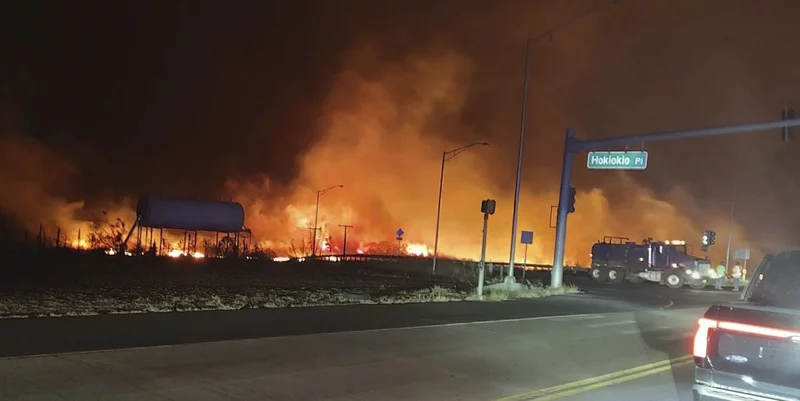
Nasionalberita.com - A blazing inferno danced its way through the heart of serene Maui, the Hawaiian gem, under the cloak of darkness last Wednesday. The firestorm consumed much of a quaint historic town, leaving its once-vibrant essence ashen, and compelling souls to leap into the embrace of the ocean in an attempt to elude the encroaching flames. A devastating toll emerged – at least six lives were extinguished, dozens injured, and a total of 271 structures either suffered damage or met their fiery demise.
As the sun dipped below the horizon, the conflagration continued its relentless march into the afternoon. The flames found sustenance from the forceful gusts emanating from Hurricane Dora, which swept well south of the Hawaiian archipelago. A looming specter haunted the minds of officials, fearing that the count of lives lost might ascend.
“This is a somber day cast in profound melancholy,” uttered Maui’s Mayor, Richard Bissen. “The weight of every life lost is a tragedy etched deeply. As we stand in mourning with their families, our prayers seek solace amidst this unrelenting darkness.”
A lull in the tempestuous winds provided a window of opportunity for certain aircraft to take flight once again. This aerial vantage point unveiled the full panorama of devastation. The U.S. Civil Air Patrol and the Maui Fire Department conducted flyovers over the coastal haven of Lahaina, thus revealing the expanse of the obliteration, disclosed Mahina Martin, the voice of Maui County.
The skyborne visuals unveiled a grim tableau – numerous homes and establishments in Lahaina lay prostrate, including the once-bustling Front Street, a haven for tourists seeking shopping and culinary delights. The oceanfront became the final resting place for smoldering heaps of debris; flames spared neither boats in the harbor nor the foliage of trees, their skeletal forms standing as eerie relics of the inferno’s passage.
“It’s a sight that chills the soul. I’ve navigated these skies for 52 years, and I’ve never borne witness to such a cataclysm,” confessed Richard Olsten, a helicopter pilot for a renowned tour company. “Tears welled in our eyes – myself, fellow pilots, even the mechanics.”
Acting Governor Sylvia Luke solemnly declared that the flames had “obliterated communities,” and she fervently implored travelers to forsake these perilous environs.
“Venturing here is to tread perilous ground,” she cautioned.
Maui’s authorities beseeched the visitors to evacuate Lahaina. The island’s response team orchestrated a sweeping “mass bus evacuation” that aimed to whisk the populace directly to the sanctuary of the airport, according to a county update.
Meanwhile, in West Maui, the relentless advance of the flames left behind a barren landscape devoid of cellular service, landlines, and electricity, a stark testament to nature’s wrath.
As the embers settled, the quest for the exact ignition source remained unresolved. A mélange of factors, including the tempestuous winds, parched humidity, and arid flora, stood as likely accomplices in the tragedy. Maj. Gen. Kenneth Hara, adjutant general for the Hawaii State Department of Defense, alluded to these elements. Additionally, experts highlighted the ominous undercurrent of climate change, which magnifies the probability of calamitous weather events.
“Climate metamorphosis is unleashing parched landscapes in various corners of the globe, primarily driven by escalated temperatures,” voiced Erica Fleishman, the steward of the Oregon Climate Change Research Institute at Oregon State University. “Even if precipitation remains constant, heightened temperatures instigate accelerated desiccation.”














